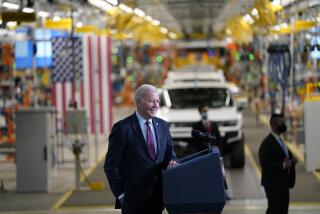U.S. poised to move ahead on climate change
The Environmental Protection Agency on Friday declared that industrial greenhouse gases are a danger to human health and well-being, opening the way to broad new regulations to reduce carbon dioxide and other planet-heating gases.
The finding could lead to far-reaching rules that are likely to heavily affect cars and trucks, which account for nearly a quarter of the nation’s greenhouse gas emissions, and utilities, which are responsible for more than a third.
Virtually all major areas of the economy could be affected, including oil, chemicals, cement, steel, forestry and large-scale farming.
The EPA finding marks a sharp change in direction from the Bush administration, which cast doubt on the science behind climate change and sought to delay government intervention. It also sends a strong signal to other nations that the U.S. is prepared to slash its contribution to greenhouse gas emissions as diplomats prepare for a December gathering in Copenhagen to negotiate a new treaty on climate change.
It also exerts pressure on Congress to move forward on comprehensive climate change legislation. Rep. Henry A. Waxman (D-Beverly Hills), co-author of a bill to create a national market to cap emissions and allow trading of credits, praised the EPA action but said it would be up to Congress to “break our dependence on foreign sources of energy and help transform our economy.”
EPA Administrator Lisa P. Jackson said addressing the climate issue would “create millions of green jobs and end our country’s dependence on foreign oil.”
But opponents of such regulation warn that it will further hurt an ailing economy. The House’s top-ranking Republican, Rep. John A. Boehner of Ohio, called the EPA’s finding “a backdoor attempt to enact a national energy tax.”
The proposed “endangerment finding,” which would be finalized after a 60-day comment period, was prompted by a Supreme Court decision in 2007 that ordered the EPA to review scientific evidence for regulating climate-altering gases under the Clean Air Act. If Congress failed to pass legislation, the agency could move forward on its own.
“The Obama administration now has the legal equivalent of a .44 magnum” to force congressional action, noted Frank O’Donnell, president of Clean Air Watch. “The bullets aren’t loaded yet, but they could be.”
President Obama has said he wants to put the country on a course to slash greenhouse gas emissions 80% by mid-century, a level scientists say is necessary to prevent the worst effects of climate change, including heat waves, flooding, sea-level rise, ocean acidification, water shortages and the widespread extinction of wildlife and plant species.
The next test of Obama’s resolve, environmentalists noted, will be the EPA’s decision on whether to grant California’s petition to proceed with its first-in-the-nation rules to cut carbon dioxide pollution from automobile tailpipes. The agency is set to make a decision by June 30.
But with a massive restructuring of the auto industry under negotiation, carmakers argue the decision on California’s auto rules should be postponed.
If it is not, 13 other states and the District of Columbia have committed to adopting California standards. That would essentially require a major increase in fuel efficiency across 40% of the U.S. car market.
“While the federal government was asleep at the wheel for years, we in California have known greenhouse gases are a threat to our health and to our environment,” Gov. Arnold Schwarzenegger said Friday. “That’s why we have taken such aggressive action.”
As a practical matter, officials said a federal endangerment finding would have little effect on California, which, in 2006, passed a comprehensive law to slash the state’s greenhouse gas emissions to 1990 levels by 2020.
Besides passing carbon dioxide rules for vehicle tailpipes, California is well along on determining how much carbon each industry is responsible for cutting.
The state has committed to obtain a third of its electricity from solar, wind and other renewable sources by mid-century. And next week it is expected to pass the world’s first regulation to ratchet down the carbon intensity of gasoline and other transportation fuels, from production to combustion.
“We welcome the federal government into the field, so the rest of the country can have the same benefits,” said Mary D. Nichols, chairwoman of the California Air Resources Board.
Cutting emissions nationwide will be far more difficult because half of the nation’s electricity is generated by coal, the most carbon-intensive fuel. Coal states, including Obama’s home state of Illinois, are lobbying heavily against tough rules on their plants.
This week, a group of eight leading conservative and free-market activists, including Grover Norquist of Americans for Tax Reform, also warned that “an endangerment finding would lead to destructive regulatory schemes that Congress never authorized. . . .
“The administration will bear responsibility for any increase in consumer energy costs, unemployment and GDP losses.”
However, William Kovacs, a vice president of the U.S. Chamber of Commerce, said that even with an endangerment finding, the EPA would be able to delay emission limits until technology improves and compliance costs fall to avoid what he called “disastrous” regulations that would all but put the agency in charge of the entire economy.
The EPA has scheduled public hearings on the finding, in suburban Washington and in Seattle. On Friday, the Sierra Club launched a campaign to generate half a million comments in support of Obama’s climate agenda.
--
margot.roosevelt@latimes.com
More to Read
Start your day right
Sign up for Essential California for news, features and recommendations from the L.A. Times and beyond in your inbox six days a week.
You may occasionally receive promotional content from the Los Angeles Times.







